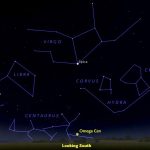
Chart at top via SkyandTelescope.com
In April and throughout the month of May, let the sparkling blue-white star Spica help you find the famous Omega Centauri globular star cluster. In mid-April, Spica and Omega Centauri climb highest up for the night at or around midnight ( 1 a.m. daylight).
What is Omega Centauri? It’s the largest and finest globular star cluster visible to the eye alone. It contains some of our Milky Way galaxy’s most ancient stars. Globular clusters are large, symmetrically shaped groupings of stars, fairly evenly distributed around the core of our Milky Way galaxy. Many northern stargazers have this particular cluster on their bucket lists because it’s located rather far to the south in our Northern Hemisphere skies.
Seeing Omega Centauri is very special in part because you can see it with your eye alone, assuming you have a dark enough sky. Very few of the Milky Way galaxy’s 250 or so globular star clusters are readily visible without optics.
Like all globular clusters, Omega Centauri is best seen through a telescope. Then you see it as a globe-shaped stellar city, teeming with an estimated 10 million stars!
How can I find Spica, and then the cluster? From Northern Hemisphere locations, you can use the Big Dipper to find Spica. Just “follow the arc” in the Big Dipper’s handle to the bright orange star Arcturus, then “drive a spike” (keep extending that arc) to Spica.
In late April and early May, Spica transits – climbs to its highest point in the sky – around 11 p.m. (12 midnight daylight saving time) for all locations around the globe. With each passing week, Spica will transit half an hour earlier. By mid-May, Spica will be transiting (appearing highest in the sky) around 10 p.m. (11 p.m. daylight saving time).
When Spica is highest in the south for Northern Hemisphere viewers, Omega Centauri is, too. When Spica is highest, look for Omega Centauri about 35 degrees directly below it. A fist at an arm’s length approximates 10 degrees.
You can see Omega Centauri with the unaided eye if your sky is dark enough and if you’re far enough south on the Earth. People living south of 35 degrees north latitude have a realistic chance of spotting the cluster over the southern horizon, though Omega Centauri has been seen as far north as Point Pelee National Park in Canada (42 degrees north latitude). Omega Centauri looks like a fairly faint (and possibly fuzzy) star.
And, of course, it’s awesome from the Southern Hemisphere.
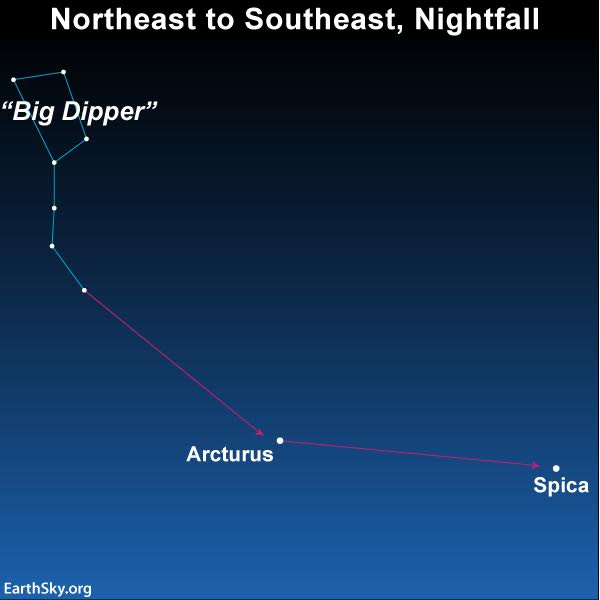
Extend the arc of the Big Dipper handle to arc to Arcuturus and to spike Spica!
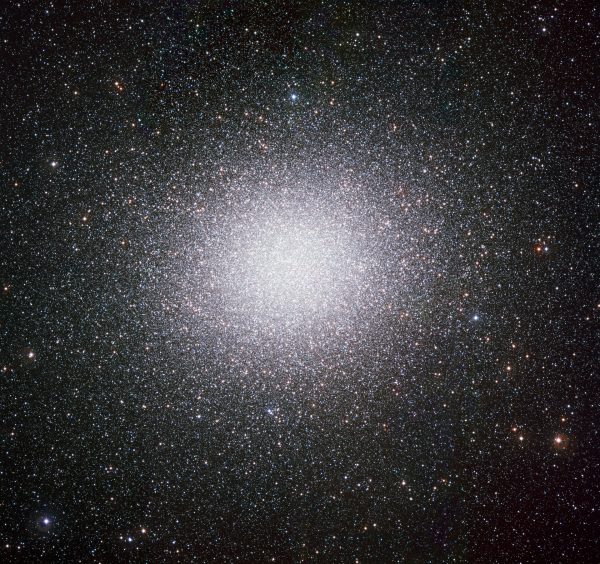
The globular cluster Omega Centauri — with as many as 10 million stars — is seen in all its splendor in this image captured from the European Southern Observatory’s La Silla Observatory in Chile.
What if I’m in the Southern Hemisphere? As seen from the Southern Hemisphere, Spica and Omega Centauri pass more nearly overhead. They still transit at approximately the same time (midnight in mid-April, 10 p.m. in mid-May). They’re still located about 35 degrees apart.
From the Southern Hemisphere, you’ve got a beautiful way to find this cluster. And, indeed, your view of the cluster will be better than ours in the north, because Omega Centauri will be higher in your sky.
To get in its general vicinity on the sky’s dome, look for the famous Southern Cross, which, officially, is the constellation Crux. Along the eastern edge of Crux is the dark Coalsack Nebula. Near the Coalsack – visible in binoculars – is the Jewel Box, an open star cluster with about 100 members, whose stars are colored red, white and blue.
If you can locate these objects, you’ll also find Omega Centauri. Consult the chart below for its location.
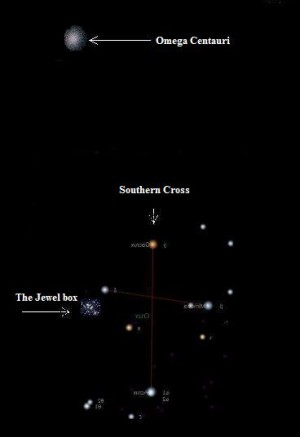
Chart via Space-Talk.
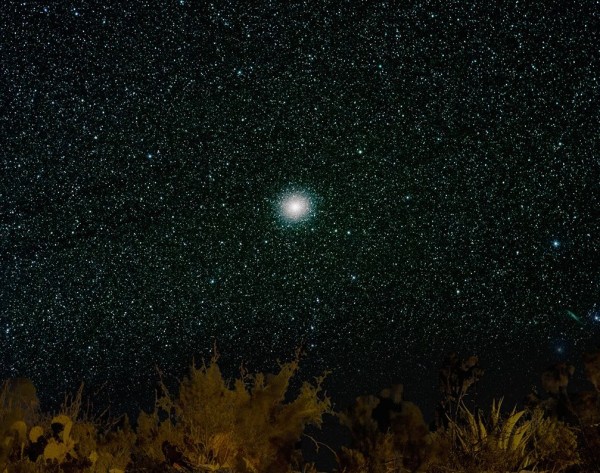
View larger. | Omega Centauri in March, 2016, by Rob Pettengill in Terlingua, Texas.
Bottom line: From the Northern Hemisphere, you can use the star Spica in the constellation Virgo to locate Omega Centauri on springtime nights! From the Southern Hemisphere, star hop from the Southern Cross, to the dark Coalsack Nebula, to the Jewel Box star cluster, to Omega Centauri.
EarthSky astronomy kits are perfect for beginners. Order today from the EarthSky store
from EarthSky https://ift.tt/2Kf95Tc

Chart at top via SkyandTelescope.com
In April and throughout the month of May, let the sparkling blue-white star Spica help you find the famous Omega Centauri globular star cluster. In mid-April, Spica and Omega Centauri climb highest up for the night at or around midnight ( 1 a.m. daylight).
What is Omega Centauri? It’s the largest and finest globular star cluster visible to the eye alone. It contains some of our Milky Way galaxy’s most ancient stars. Globular clusters are large, symmetrically shaped groupings of stars, fairly evenly distributed around the core of our Milky Way galaxy. Many northern stargazers have this particular cluster on their bucket lists because it’s located rather far to the south in our Northern Hemisphere skies.
Seeing Omega Centauri is very special in part because you can see it with your eye alone, assuming you have a dark enough sky. Very few of the Milky Way galaxy’s 250 or so globular star clusters are readily visible without optics.
Like all globular clusters, Omega Centauri is best seen through a telescope. Then you see it as a globe-shaped stellar city, teeming with an estimated 10 million stars!
How can I find Spica, and then the cluster? From Northern Hemisphere locations, you can use the Big Dipper to find Spica. Just “follow the arc” in the Big Dipper’s handle to the bright orange star Arcturus, then “drive a spike” (keep extending that arc) to Spica.
In late April and early May, Spica transits – climbs to its highest point in the sky – around 11 p.m. (12 midnight daylight saving time) for all locations around the globe. With each passing week, Spica will transit half an hour earlier. By mid-May, Spica will be transiting (appearing highest in the sky) around 10 p.m. (11 p.m. daylight saving time).
When Spica is highest in the south for Northern Hemisphere viewers, Omega Centauri is, too. When Spica is highest, look for Omega Centauri about 35 degrees directly below it. A fist at an arm’s length approximates 10 degrees.
You can see Omega Centauri with the unaided eye if your sky is dark enough and if you’re far enough south on the Earth. People living south of 35 degrees north latitude have a realistic chance of spotting the cluster over the southern horizon, though Omega Centauri has been seen as far north as Point Pelee National Park in Canada (42 degrees north latitude). Omega Centauri looks like a fairly faint (and possibly fuzzy) star.
And, of course, it’s awesome from the Southern Hemisphere.

Extend the arc of the Big Dipper handle to arc to Arcuturus and to spike Spica!

The globular cluster Omega Centauri — with as many as 10 million stars — is seen in all its splendor in this image captured from the European Southern Observatory’s La Silla Observatory in Chile.
What if I’m in the Southern Hemisphere? As seen from the Southern Hemisphere, Spica and Omega Centauri pass more nearly overhead. They still transit at approximately the same time (midnight in mid-April, 10 p.m. in mid-May). They’re still located about 35 degrees apart.
From the Southern Hemisphere, you’ve got a beautiful way to find this cluster. And, indeed, your view of the cluster will be better than ours in the north, because Omega Centauri will be higher in your sky.
To get in its general vicinity on the sky’s dome, look for the famous Southern Cross, which, officially, is the constellation Crux. Along the eastern edge of Crux is the dark Coalsack Nebula. Near the Coalsack – visible in binoculars – is the Jewel Box, an open star cluster with about 100 members, whose stars are colored red, white and blue.
If you can locate these objects, you’ll also find Omega Centauri. Consult the chart below for its location.

Chart via Space-Talk.

View larger. | Omega Centauri in March, 2016, by Rob Pettengill in Terlingua, Texas.
Bottom line: From the Northern Hemisphere, you can use the star Spica in the constellation Virgo to locate Omega Centauri on springtime nights! From the Southern Hemisphere, star hop from the Southern Cross, to the dark Coalsack Nebula, to the Jewel Box star cluster, to Omega Centauri.
EarthSky astronomy kits are perfect for beginners. Order today from the EarthSky store
from EarthSky https://ift.tt/2Kf95Tc

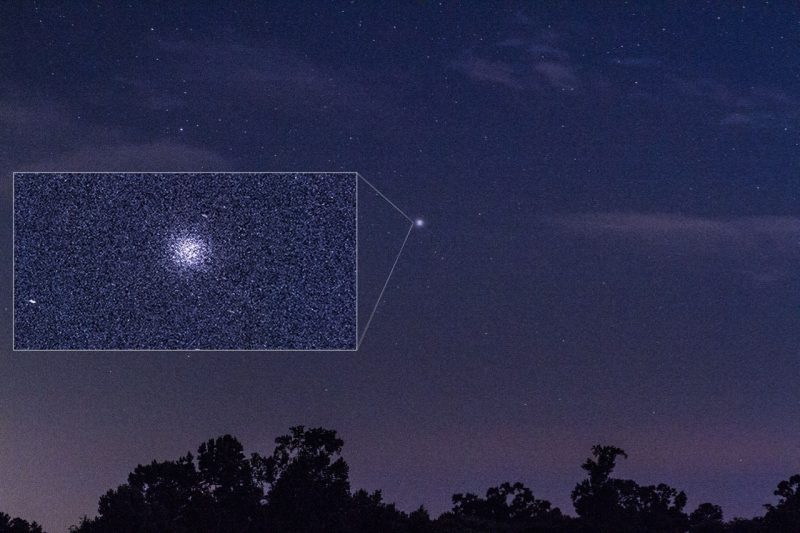
Aucun commentaire:
Enregistrer un commentaire